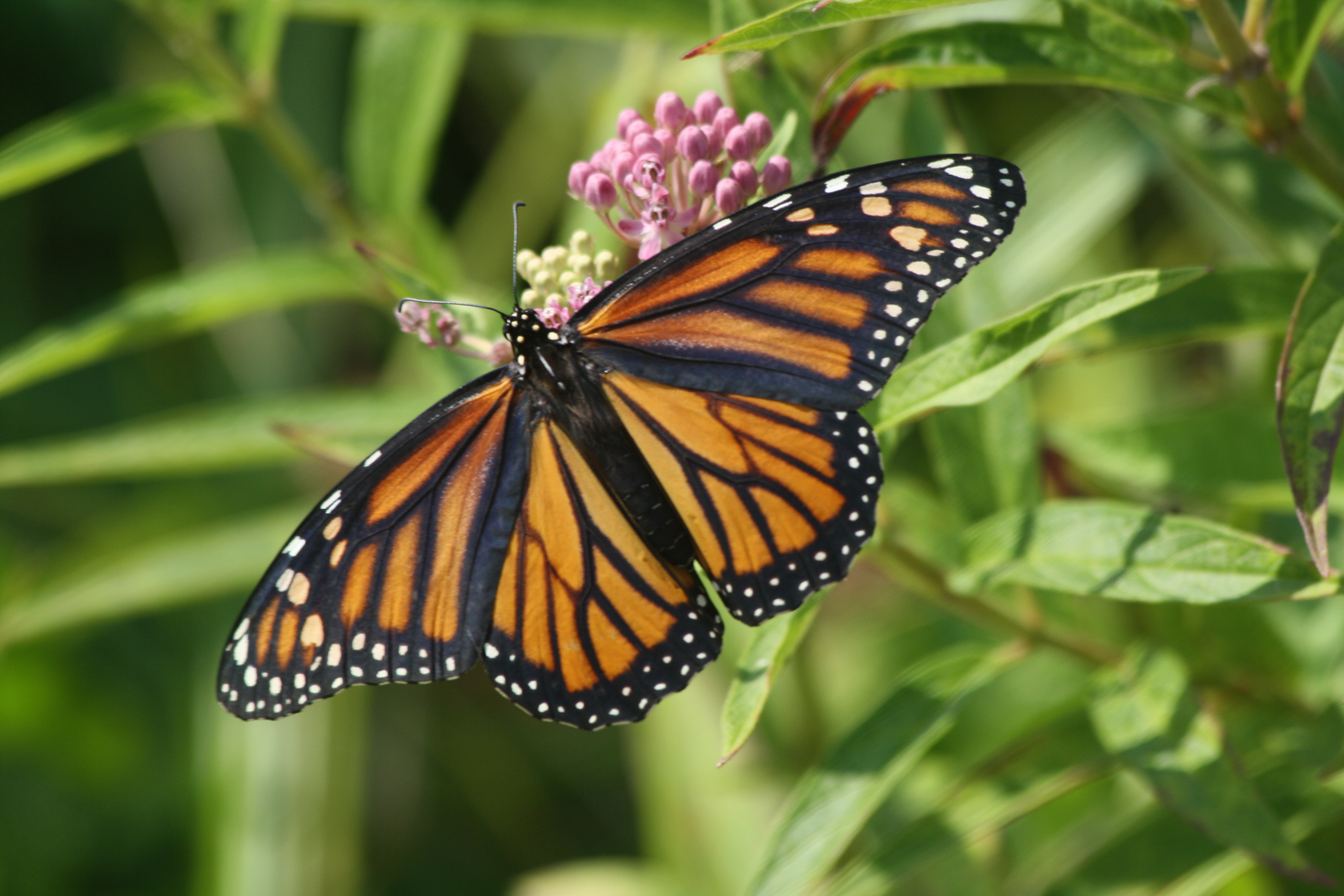NOTE: This event is still happening, despite the rain. The listed rain location is the Girls’ Club.
Lori Stralow Harris thinks personal connection is the way to change someone’s mind. That’s why she, along with the Bird, Tree & Garden Club, plans to get Chautauquans close – really close – to monarch butterflies and convince them why they matter.
Four years ago, Harris was a volunteer cleaning fossils when a gardener interrupted to ask for help feeding some caterpillars. She helped out, but wasn’t thrilled – at least, not until she saw the insects’ beautiful range of chrysalises. It was then that Harris, an artist and educator, became hooked on butterflies.
“It’s all about the life cycle,” she said.
Harris, owner of the Salt Creek Butterfly Farm in Countryside, Illinois, will present a BTG Brown Bag lecture at 12:15 p.m. Tuesday in Smith Wilkes Hall. She will also present an interactive exploration of the monarch life cycle beginning at 12:15 p.m. Friday in Lincoln Park.
Those events are part of a season-long BTG initiative to raise awareness about the decline of the monarch butterfly. Lynda Acker, the BTG board member heading the monarch initiative, said she believed in the effort both for the monarch’s sake, but also the species’ larger meaning for environmental conservation.
“It’s everything from GMO crops, to pesticide overuse, to illegal logging to any number of things where we’re marginalizing these amazing creatures,” Acker said.
Harris’ Brown Bag will focus on the threats facing the roughly 60 million monarch butterflies that migrate across North America each year. Monarch butterflies are the only insect species known to traverse that distance, a distinction heightened by the step-by-step progress of the return migration.
Monarchs take as many as five generations to reach their final mating grounds in the region surrounding Chautauqua. Those northernmost monarchs make the trek to central Mexico, where a large portion of the North American monarchs pack into a few acres of fir and pine trees to wait out the winter.
When spring arrives, that group proceeds north to southern Texas, where they lay their eggs and die. The subsequent generations, which will only live two or three weeks, continue that process several times until they reach the northern United States and Canada. Here, the final group, called the “super generation,” is hatched and will live about eight months to make the journey back to Mexico.
“It’s incredible on a cellular level that an organism can do that,” said Acker, a biologist by training.
But that migratory life cycle is in danger. Commercial agriculture employs powerful herbicides to rid fields of unwanted plant life, including milkweed, the monarch butterfly’s sole host plant. That, coupled with habitat loss caused by development and aggressive landscaping along transportation corridors, has led to an almost 90 percent decline in monarch population over the past two decades.
The scale of those issues may cause certain individuals to wash their hands of responsibility, but Harris said everyone is part of the problem, at least if they use herbicides or insecticides inappropriately. She said even something as seemingly benign as a dog’s flea medicine can harm monarch caterpillars and butterflies through contact.
Today’s lecture will talk strategies for supporting the monarch population as it conducts its continent-spanning migration. The stakes are large, Harris said, but the solutions start small, like planting milkweed and nectar plants — flowers — in home gardens and throughout communities. At the same time, Harris said it’s important to let go of ideas of landscaping perfection; milkweed is a monarch caterpillar’s food, and that means they will devour the leaves of those plants. A healthy butterfly habitat, she said, will inevitably have some ragged looking plants.
For Friday’s event, Harris shipped specimens of monarchs ranging from egg to caterpillar to chrysalis to butterfly overnight to Chautauqua from a farmer in Pennsylvania in order to demonstrate the monarch’s life cycle.
Like a holiday shipment of Omaha Steaks, the butterflies travel in breathable envelopes filed away into compartments cooled by blocks of insulated ice. Exposed to cold, Harris said, the monarchs go into a resting state that allows butterflies to chill out en route to their destination.
At Lincoln Park, Harris will unbox the specimens and assemble a series of stations for Chautauquans to observe the monarch develop from egg to adult.
Period-sized dots — that’s how big a single monarch egg is, adhered to the cone of finger-like leaves situated below the head of orange milkweed flowers. Those eggs hatch in a couple days, revealing a black, white and yellow-striped caterpillar almost too small to see. Once freed, the caterpillars eat and eat, devouring their weight in milkweed leaves each day.
The “little eating, mowing machines,” as Harris called them, march up and down the milkweed on 16 legs, growing up to 3,000 times their original size as they perforate the leaves of their host with their tiny mouths. The larval stage lasts about two weeks, during which monarch caterpillars shrug off layers of outgrown skin five times to accommodate growth from almost indistinguishable to the size of a child’s finger.
Eventually, the caterpillars exit their milkweed host to find a safe place to rest, where they spin a silk mat, stab a stem-like appendage into it and dangle upside down. Here, the caterpillar sheds its skin one last time and the next layer of rippled skin slowly hardens into a stiff, j-shaped chrysalis. For two weeks, the caterpillar rests inside the jade-colored shell, protected from outside distractions as its pigments darken and the butterfly develops.
Finally, the familiar orange and black monarch butterfly emerges, wings crumpled and wet. It takes about an hour for the butterfly’s wings to dry out and become usable. Immediately the butterfly seeks out nectar and sips from its straw-like tongue, which rolls and unrolls like a party blower. The adult butterflies are ready to mate within days of emerging from the chrysalis, prepared to start the cycle again.
Acker, the Monarch Moment organizer, said up to 100 Chautauquans at a time will be able to witness Harris’ microcosm of that life cycle. Participants will be able to see eggs on milkweed, measure caterpillars, observe chrysalises and feed butterflies various nectar sources across six separate stations.
The demonstrations will be fascinating, Acker said, but, more importantly, they will help participants understand the complexity of the monarch life cycle and underscore the care required to preserve the fragile process.
Even more, Jack and Diane Voelker, the first Monarch Moment presenters who’ve shared similar demonstrations with their grandchildren, said the hands-on connection between children and butterflies can be instant and inspire compassion for other, less friendly insects such as bees.
“It’s a little more difficult to have a personal experience with some other species, but a monarch will literally just sit there for a while,” Jack Voelker said.
Harris said that lesson applies to people on either end of life. Harris introduced an adopt-a-caterpillar program at a retirement community where residents would enter a garden, pick a caterpillar and raise it to maturity. She found herself constantly answering house calls from curious residents about their caterpillars, even providing magnifying glasses and flashlights to help them locate their tiny specimens in the provided enclosures. She even recalled one woman staying up all night waiting for her butterfly to emerge from its chrysalis, cooking the butterfly spaghetti just in case it was hungry.
“It’s the enthusiasm of a child and the love of a parent. It’s so, so lovely,” Harris said.
The lesson from both age groups, Harris said, is that monarch conservation isn’t complicated and doesn’t require an advanced degree — Harris holds a Bachelor of Fine Arts and a Master of Arts, after all.
“I’m not a scientist, I’m an artist,” Harris said. “I’m a regular person who’s observing and interested — that’s enough.”
(Photo from Flickr.com)





